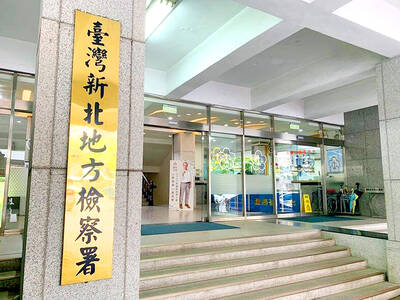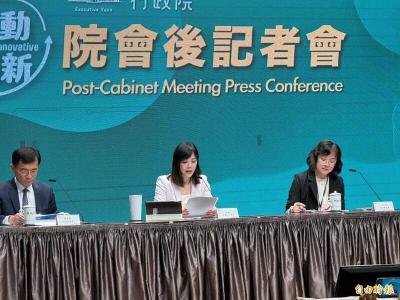The devastation wrought by Typhoon Morakot left hundreds of thousands of tonnes of driftwood to clean up, rekindling a debate over the ownership and disposal of driftwood, which in such large quantities could be very lucrative.
“It’s an environmental problem, yet even such a colossal amount as was left behind this time is not enough to attract attention to the environmental damage,” said Lin Shu-ling (林淑玲), a resident of Taitung County’s Fushan Village (富山) in Beinan Township (卑南鄉).
Lin is a member of the Amis Tribe, which in recent decades has been forced to move from mountainous areas to villages nearer the coast as its lands were expropriated by the government.
Driftwood is a common sight along the coast after a typhoon, Lin said, but he has never seen this much.
Official estimates put the amount of driftwood left from Morakot at 980,000 tonnes, about 45 times the estimate after Typhoon Mindulle in 2004.
That represents about 19,000 hectares of timber, or 0.7 percent of mountain areas.
Control Yuan member Chen Yung-hsiang (陳永祥), who has inspected the driftwood crowding the Gaoping River (高屏溪) basin and the situation in mountainous areas after Morakot, said the government should review its forest management policy to put an end to the long-running problem of illegal logging.
But Forestry Bureau Deputy Director-General Lee Tao-sheng (李桃生) said it was “the astonishing amount of precipitation” that triggered massive avalanches of rocks, earth and driftwood according to a group of academics who inspected the areas.
Lee said the report found that landslide areas were largely covered with vegetation, while the driftwood was from uprooted, not felled, trees.
The shapes of sections of tree trunks washed downhill indicated the trees had been torn apart by natural forces and not felled by humans.
“It is wrong to blame the disaster on the government’s forest management policy. When more than 400mm of rain falls within 24 hours, it can trigger landslides. Morakot brought more than 1,900mm of rain,” Lee said.
Some environmentalists disagree with the bureau, saying its management of forests and disposal of driftwood indicate that the bureau values natural resources based solely on their economic potential.
Lee Ken-cheng (李根政), director of Mercy on the Earth, Taiwan, agreed that massive landslides were the main cause of the driftwood. However, just because the amount of driftwood that bore signs of being felled was small does not mean that illegal felling was not a serious factor.
Overdevelopment uphill from areas that experienced landslides also played a role, he said.
In recent years, some reports have claimed that illegal logging increases in the days before a typhoon to boost the amount of driftwood washed downhill.
“The government’s forest protection system is fraught with problems. Hillsides and forest land have been overdeveloped and overrun by human activity because of lax regulations concerning land use,” Lee Ken-cheng said.
Authorities also allow officials to collude with illegal loggers by turning a blind eye, Lee Ken-cheng said.
Huang Yuan-jung (黃苑蓉), a volunteer with Lin’s Fushan Community Development Association, said the forestry management agency had planted trees too close to each other in reforested areas. This, along with illegal logging and land exploitation all contributed to the massive amounts of driftwood swept downhill.
“There were many landslides in reforested areas in the mountains where there wasn’t enough space for trees’ roots to grow. [Their] roots had curled up instead of spreading out to absorb as much water as possible,” Huang said, referring to upstream areas along the Luye River (鹿野溪) that she inspected after the typhoon.
Under regulations for handling driftwood from natural disasters, a local government gets half of the profits from sales of driftwood within its boundaries. The other half goes to the central government.
Article 15 of the Forestry Law (森林法) requires that local governments mark high-value timber within a month of the disaster. Unmarked timber then becomes available for residents to collect.
As driftwood from Typhoon Mindulle generated NT$130 million in government profits, it is estimated that the driftwood left by Morakot will generate NT$5.85 billion (US$180.63 million).
But claims soon surfaced that some Aborigines had violated regulations for collecting driftwood, highlighting a longstanding controversy over ownership rights stemming from the government’s reluctance to recognize Aboriginal land rights.
“Under the Forestry Law, the state has ownership as there are no rules granting legal status to traditional Aboriginal territory,” Lee Tao-sheng said.
But an official who handles land management affairs at the Council of Indigenous Peoples disagreed.
“Aboriginal peoples are granted ownership by Article 15 of the Forestry Law to use resources within their tribal areas,” said the official, who wished to remain anonymous.
“There is no need for legislation defining traditional Aboriginal territories because they are the de facto habitats of Aborigines,” he said.
A bill requiring the government to recognize the territorial rights of Aborigines — for both land and sea — has yet to be discussed in the legislature.
The official said the council had spent six years on researching a report that identified 40 percent of the country’s area as traditional Aboriginal territory, but that the report had been pigeonholed by the Cabinet.
Most of the high-value timber to be sold or auctioned is valuable for producing luxury furniture, but “driftwood means much more than [monetary profit] to Aborigines,” Huang said.
“For Aboriginal people who identify with their cultural heritage and are equipped with the skills to live the tribal life, it is a shame to sell driftwood as if it were just any commodity. Driftwood can be used by Aboriginal tribes to produce many things, and this is more than urban [non-Aboriginal] people can imagine,” Huang said.
Liu Chiung-hsi (劉炯錫), a professor in the Department of Natural Sciences at National Taitung University, said driftwood holds special significance for Aboriginal peoples.
“Tjavalj, as the Paiwan call Taimali Township [太麻里], means ‘place where driftwood gathers,’” Liu said. “Beinan’s Semagan tribe also has a legend that the spirits of their ancestors carve driftwood to tell their future descendents the lore of their tribe and tribal life.”
Over the years, driftwood art has become a flourishing cultural industry in Aboriginal villages. The Council of Cultural Affairs has recognized the village of the Semagan tribe as an “art village” for its woodcarving, while Doulan Village of the Amis tribe is famous for furniture and decorations made from driftwood.
But driftwood also has a role to play in the accumulation of coastal sand and health of coastal forests, Liu said, adding that the government should heed its cultural and ecological significance.

ECHOVIRUS 11: The rate of enterovirus infections in northern Taiwan increased last week, with a four-year-old girl developing acute flaccid paralysis, the CDC said Two imported cases of chikungunya fever were reported last week, raising the total this year to 13 cases — the most for the same period in 18 years, the Centers for Disease Control (CDC) said yesterday. The two cases were a Taiwanese and a foreign national who both arrived from Indonesia, CDC Epidemic Intelligence Center Deputy Director Lee Chia-lin (李佳琳) said. The 13 cases reported this year are the most for the same period since chikungunya was added to the list of notifiable communicable diseases in October 2007, she said, adding that all the cases this year were imported, including 11 from

Prosecutors in New Taipei City yesterday indicted 31 individuals affiliated with the Chinese Nationalist Party (KMT) for allegedly forging thousands of signatures in recall campaigns targeting three Democratic Progressive Party (DPP) lawmakers. The indictments stem from investigations launched earlier this year after DPP lawmakers Su Chiao-hui (蘇巧慧) and Lee Kuen-cheng (李坤城) filed criminal complaints accusing campaign organizers of submitting false signatures in recall petitions against them. According to the New Taipei District Prosecutors Office, a total of 2,566 forged recall proposal forms in the initial proposer petition were found during the probe. Among those

The Mainland Affairs Council (MAC) today condemned the Chinese Communist Party (CCP) after the Czech officials confirmed that Chinese agents had surveilled Vice President Hsiao Bi-khim (蕭美琴) during her visit to Prague in March last year. Czech Military Intelligence director Petr Bartovsky yesterday said that Chinese operatives had attempted to create the conditions to carry out a demonstrative incident involving Hsiao, going as far as to plan a collision with her car. Hsiao was vice president-elect at the time. The MAC said that it has requested an explanation and demanded a public apology from Beijing. The CCP has repeatedly ignored the desires

The Ma-anshan Nuclear Power Plant’s license has expired and it cannot simply be restarted, the Executive Yuan said today, ahead of national debates on the nuclear power referendum. The No. 2 reactor at the Ma-anshan Nuclear Power Plant in Pingtung County was disconnected from the nation’s power grid and completely shut down on May 17, the day its license expired. The government would prioritize people’s safety and conduct necessary evaluations and checks if there is a need to extend the service life of the reactor, Executive Yuan spokeswoman Michelle Lee (李慧芝) told a news conference. Lee said that the referendum would read: “Do